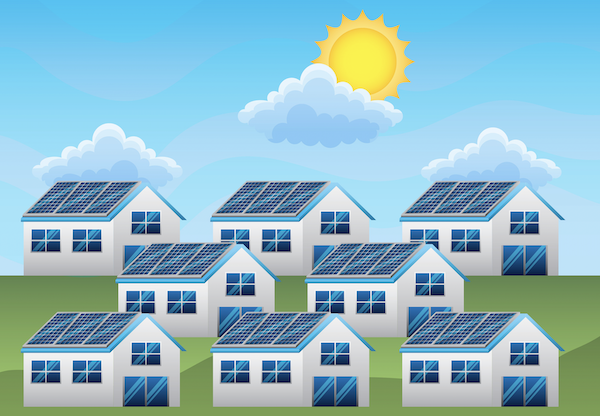Back-of-the-Envelope Feasibility Calculations
Millions More Installations Would Have a Significant Impact
This article takes a broad look at the feasibility and potential benefits of widely-deployed rooftop solar photovoltaic (PV) panels, limited to residential properties in the US. It is estimated that there are currently about 3 million residential solar PV installations in the US. What is the impact on CO2 emissions if we take that number to 30 million? Rough calculations indicate a potential to offset 0.4% of global CO2 emissions and 3% of US CO2 emissions. That’s a significant step.
Inventors, engineers and entrepreneurs frequently use rough calculations, “back-of-the-envelope” scratchings, to gauge feasibility of all kinds of ideas. Such calculations involve estimates, assumptions and guesses. That’s the approach taken in this article.
If feasibility calculations start with facts, and keep assumptions and guesses on the conservative side, this sort of approach can produce some useful results. Sometimes these calculations are surprisingly accurate, other times they’re a complete miss.
Why Increase Rooftop Solar?
Because it is relatively easy:
- The vast majority of homeowners can install solar PV without the need for permission from someone else
- A home’s electric service is an easy, low cost point of connection to the utility electric grid
- As more systems are installed with smart inverters (also called grid-forming or grid support inverters) rooftop solar will help stabilze electric grids
- Using the roof surface for solar panels is not controversial (as compared to, for example, using agricultural land for a solar farm)

Assumptions
- There are about 75 million single-family detached homes in the US. Perhaps 65% of those rooftops are suitable (not excessively shaded, reasonable orientation to the path of the sun). 65% of 75 million is 49 million. For this analysis, we’ll use a conservative figure: 30 million.
- Capacity factor is generally defined as the ratio of actual annual output to output at rated capacity for an entire year. This varies, of course, geographically, as southern portions of the US get 40% more sun than northern locations, on average. For this analysis, we’ll assume 16%. (I.e., the solar PV system will produce power for 16% of the available hours in a year – a conservative estimate.)
- Systems are typically sized to supply 90 to 100% of the home’s power over the course of the year. We’ll assume a 10 kW system size, which can produce about 14,000 kWh/year. The US Energy Information Administration says the average home consumes 11,000 kWh/year as of 2019. Since that number will go up as more people convert fossil fuel appliances to electric, and as more electric vehicles are sold, we’re using a higher number.
- In the US, an average of 0.822 pounds (0.373 kg) of CO2 is emitted at the power plant for every kWh of electricity produced
The Calculations
- Solar power production for 16% of the hours in a year = 1,402 hours annually
- For a 10 kW system, 10 kW x 1,402 hours x 30 million = 420,600,000,000 kWh per year (which is 421 TWh (terawatt-hours)
- 420 TWh x 0.822 lbs = 346 billion pounds of CO2, which is equal to 157 billion kg
- 157 billion kg = 157 million metric tons of CO2, which is equal to 0.16 gigatons of CO2 (GtCO2). A gigaton is 1 billion metric tons.
- Global CO2 emissions in 2022 were about 37 Gt, so 0.16 Gt avoided using solar is around 0.4%
- US CO2 emissions in 2022 were about 5 Gt, so 0.16 Gt avoided using solar PV is around 3%.
The Cost
Installed cost for a rooftop solar PV system can vary widely. If we use a figure of $20,000 as an average (after the US federal tax credit), the total cost for 30 million systems would be $600 billion. This is just a ballpark figure and, yes, that’s a lot of money. If we spread the 30 million systems goal over a period of 6 years it would be $100 billion a year (neglecting inflation).
Reality
If the US wants to lower its annual CO2 emissions, residential rooftop solar PV is a relatively easy way to make a significant contribution toward that goal. More substantial incentives are needed, however, to make this a better deal for homeowners. The current 30% federal tax credit is nice, but the economics of a solar PV investment are not attractive: the typical break even point can be 12 years or more. The tax credit plus a combination of rebates and low-interest long-term loans could make rooftop installations much more attractive.
There’s plenty of opportunity to grow this renewable energy source. According to Google’s Project Sunroof, the zip code where I live has 7,400 residential roofs and 96% of those are viable for solar PV. The potential generating capacity is 100,000 MWh per year. However, fewer than 100 solar PV systems are installed in this zip code.
What are we waiting for? (Answer: A better rate of return on the investment.)
More Reality and Unknowns
As with any energy technology, there are many challenges to minimizing environmental impact. When you look at the entire life-cycle of solar PV panels, the industry has numerous issues to address:
- Panels that fail, are taken out of service, or reach the end of their useful life are a challenge to recycle. By 2030, there could be up to a million tons of solar panel waste. More recycling providers are needed and panel manufacturers need to participate by supporting a circular economy.
- Solar PV panels are emissions free in operation, but there’s a carbon footprint associated with production. A widely referenced study from 2014 estimated 3 years of operation was needed to offset the carbon footprint of a PV panel. The industry is beginning to address this challenge. For example, Hanwha Qcells Co., Ltd. of South Korea states that one of its 425 watt panels has a carbon footprint of 386 kg CO2 per kW rating, one of the lowest in the market. So, the 425 watt panel would have a footprint of about 164 kg CO2. Using our assumptions for operating hours per year and the US average of 0.373 kg CO2 per kWh, it would take about 9 months of operation for this panel to offset its carbon footprint.
- Systems need to be maintained and kept in operation. Homeowners aren’t experienced with electric power generation systems, so solar installers and service companies need to step up to the challenge.
Summary
As other renewable energy options encounter opposition to deployment at scale, rooftop solar PV is worth pursuing more aggressively in the near-term. If you can handle the capital outlay or loan payments, jump in! (Remember that after passing the break-even point, the system generates pure cash. Your cost of the generated electricity is also immune to inflation.)
Encourage your energy policymakers and elected representatives to do more to support rooftop solar PV. It’s one of the easiest ways to increase deployment of renewable energy. We can do it now, at scale, while the country continues to work on development and deployment of other alternative energy technologies.
Update 06/28/23: As an added data point, the US NREL report “Examining Supply-Side Options to Achieve 100% Clean Electricity by 2035” uses an assumption that 190 GW of rooftop solar would be installed by 2035 as part of the overall strategy. If 10 kW per system is assumed, that’s 19 million rooftops. https://www.nrel.gov/analysis/100-percent-clean-electricity-by-2035-study.html
For further reading:
The U.S. Has Billions for Wind and Solar Projects. Good Luck Plugging Them In, NY Times, by Brad Plumer, February 23, 2023 https://www.nytimes.com/2023/02/23/climate/renewable-energy-us-electrical-grid.html
First Solar’s recycling program: https://www.firstsolar.com/en/Solutions/Recycling
Economics of Green Investments, Cash Flow and Return on Investment, by David Pickut, August 25, 2022
https://medium.com/@dpickut2/economics-of-green-investments-part-1-615348a7c8ab
